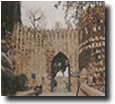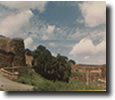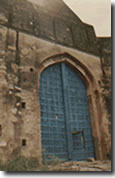 History Jhansi City
History Jhansi City
 |
Jhansi
city, situated between the rivers Pahunj and Betwa
is a symbol of bravery, courage and self respect.
It is said that in ancient times Jhansi was a part
of the regions Chedi Rashtra, Jejak Bhukti, Jajhoti
and Bundelkhand.Jhansi was a stronghold of the Chandela
kings. Balwant Nagar was the name of this place.
But in 11th. century Jhansi lost its importance.
In 17th. century under Raja Bir Singh Deo of Orchha
Jhansi again rose to prominence.Raja Bir Singh Deo
had good relations with the mughal emperor Jehangir.In
1613 Raja Bir Singh Deo constructed the Jhansi fort.
He died in 1627. After his death his son Juhar Singh
succeeded him.Maharaja Chhatrasal Bundela of Panna
was a good administrator and a brave warrior. In
1729 Mohammed Khan Bangash attacked Chhatrasal.
Peshwa Baji Rao(I ) helped Maharaja Chhatrasal and
defeated mughal army. As a mark of gratitude Maharaja
Chhatrasal offered a part of his state to Maratha
Peshwa Baji Rao(I). Jhansi was also included in
this part.In 1742 Naroshanker was made the subedar
of Jhansi.During his tenure of 15 years he not only
extended the Jhansi fort which was of strategic
importance but also constructed some other buildings. |
 |
The
extended part of the fort is called Shankergarh.In
1757 Naroshanker was called back by the Peshwa.
After him Madhav Govind Kakirde and then Babulal
Kanahai were made the subedars of Jhansi.In 1766
Vishwas Rao Laxman was made the subedar of Jhansi.His
period was from 1766 to 1769. After him Raghunath
Rao (II) Newalkar was appointed the subedar of Jhansi.
He was a very able administrator. He increased the
revenue of the state.The MahaLaxmi Temple and the
Raghunath Temple were built by him. For his own
residence he constructed a beautiful building Rani
Mahal in the city. In 1796 Raghunath Rao passed
the subedari in favour of his brother ShivRao Hari.In
1803 a |
 |
treaty was signed between
East India company and Maratha. After the death of
Shiv Rao his grand son Ramchandra Rao was made subedar
of Jhansi. He was not a good administrator. Ramchandra
Rao died in 1835. After his death Raghunath Rao (III)
was made his successor. In 1838 Raghunath Rao(III)
also died. The British rulers then accepted Gangadhar
Rao as the Raja of Jhansi.Due to the inefficient administration
during the period of Raghunath Rao (III) the financial
position of Jhansi was very critical.Raja Gangadhar
Rao was a very good administrator. He was very generous
and full of sympathy. He gave very good administration
to Jhansi. During his period the local population
of Jhansi was very satisfied. |
 |
In 1842 Raja Gangadhar Rao
married to Mannikarnika. After this marriage Mannikarnika
was given the new name Laxmi Bai , who led forces
against British in 1857. She sacrificed her life to
the cause of Indian Independence in 1858.In 1861 the
British Government gave the Jhansi fort and Jhansi
city to JivajiRao Scindia. Jhansi was then became
a part of Gwalior state. In 1886 Britishers took back
Jhansi from Gwalior state.In independent India Jhansi
was included in Uttar Pradesh.At present Jhansi is
a Divisional Commissioner's Headquarter including
district Jhansi, Lalitpur and Jalaun.Rani Laxmi Bai,
the fiery Queen of Jhansi, also known as the Rani
of Jhansi, one of the great nationalist heroine of
the first war of Indian freedom, |
 |
a symbol
of resistance to the British rule in India was born
on 19th November 1835 at Kashi (Presently known
as Varanasi). Her father Moropanth was a Brahmin
and her mother Bhagirathibai was a cultured, intelligent
and god fearing lady.Mannikarnika (Manu) was the
name of Rani Laxmi Bai in her childhood. Manu lost
her mother at the age of four. The Complete responsibility
of the young girl fell on the father. She completed
her education and also learned horse riding, Sword
fighting and shooting on a target with a gun.She
was married to Raja Gangadhar Rao, the Maharaja
of Jhansi in 1842, and became the Rani of Jhansi.
After the marriage She was given the name Laxmi
Bai. The Marriage ceremony was performed in Ganesh
Mandir, the temple of Lord Ganesha situated in the
city of Jhansi.Rani
Laxmi Bai gave birth to a son in 1851, but unfortunately
this child died when he was about four months old.
After this tragedy, Damodar Rao was adopted a son.
Later on Maharaja Gangadhar Rao also died on 21st
November 1853.After the death of Maharaja Gangadhar
Rao, Rani Laxmi Bai was left alone. At this time
she was eighteen years old.Rani Laxmi Bai did not
lost her courage, She always remembered her responsibility. |
| |
|
|
|
+ |